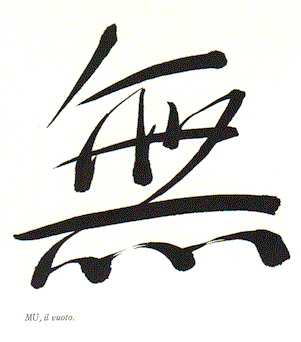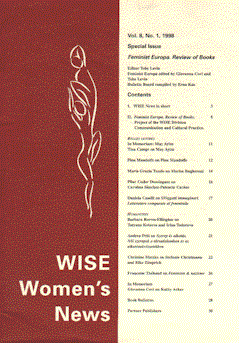|
Maria Grazia Tundo Saggi e scritture |
||
| HOME PAGE SAGGI Lo spazio del cinema: specchio di vita La riscrittura della fiabe: La camera di sangue di Angela Carter L'impossibilità dell'autobiografia.L'amant di Marguerite Duras Estraneità e parola. Simultan di Ingeborg Bachmann Il corpo impuro della luna. Salomè di O. Wilde Le voci dell'in-concepibile nel
sogno di una scrittura: Frankenstein di Mary W. Shelley SCRITTURE RECENSIONI Fiction, Fact, in Flux. Marisa Bulgheroni, Apprendista del sogno (in Italiano)
Maria Grazia Tundo 1999 |
At first, Marisa Bulgheroni’s stories in Apprendista del sogno [Dream apprentice] seem to be autobiography, but in fact they aren’t. Quite the opposite. Bulgheroni had to give up on the autobiography she had envisioned as the project of a lifetime in order for the short stories to come. Since childhood, she had been gathering fragments of herself, documents, traces she hoped to organise into a coherent and truthful self-portrait, discovering, however, that the auto-referential had to go up in smoke before she could really begin to write, because narrating means collecting the few hard scattered fragments that escape the flames and trying to assemble them. Thus autobiography is impossible if we mean the detailed and meticulous description of real events leading to precise and final understandings. For our lives don’t find meaning simply in the brutality of events, the sharp memory of facts. On the contrary, subjectivity inscribes itself halfway between the historical occurrence and the dreamed or imagined one. Our experience, continuously narrated, multiplies identity, shattering it. According to Marisa Bulgheroni, narrating has nothing to do with referential accuracy or documentary exactitude. The "catastrophic child" the writer once was can find the truth she was looking for only in the processing of identities that fiction allows. Bulgheroni’s writing therefore aims at "busting ghosts," mingling dream and reality. The ’I’ is insubstantial, built through a never-ending process of weaving with numerous far-away voices, times, and places structuring the plot of subjectivity. This challenges readers to isolate profile of the desired and fancied body of the writer we want to picture when we read. By doing so, we share the writer's attitude because, as Bulgheroni puts it, "the detective story is the pattern of narration itself." Both the writer and her readers belong to the imaginary realm where we vainly strive to grasp desire’s object. Eschewing narrative devices to disclose the supposed objective truth of an event, Bulgheroni’s tales reveal no inclination to solve enigmas. They lead us to pile up clues, provocatively scattered further and further in a continuous play of deferrals, but we never arrive at an univocal answer. There is referential uncertainty because signs are equivocal, especially when dreams are so closely linked to reality that distinctions between them are blurred. In this way, we are always reminded of the imaginary status of the ego. Running through the collection are three main themes: genealogy, or questioning identity while attending to ancestral voices; love, conflicted venue par excellence; and History, in books and in life, experienced by an embodied subjectivity, a singular ungeneralizable viewpoint. And a fourth pervasive theme is the journey, a metaphor for endless research and an escape from loves and places that efface mastery over oneself. In these stories, all places are full of voices continuously modifying themselves in amazing alchemical ways and turning into inner landscapes, their physical, factual reality altered through mythical, pictorial, literary reminiscences; they are densely inhabited spaces ceaselessly metamorphosing, becoming the objective correlative of the deepest inner experiences. To illustrate, let’s take Sicily and the north of Italy, two sites between which the writer splits her life. The former, hot and volcanic, a paradoxical land, is the proper background for incomprehensible passions, experienced as infernal, which closely follow the myth of Persephone’s abduction by the god of Hades. Being in love is connoted as being torn between the temptation to yield to the southern isle’s seduction (with its tongues of flame and volcanic shadows) or to go back to northern clarity and reason, since in the north one can write and produce; nostalgia can be controlled, nostalgia for the loss of oneself that often goes with passion. The island is also that part of oneself connoted as shadow, free of control by reason, a place of excess; it is much more than the mere background to an event. In these short stories, then, love is always positioned in the distance between two places, in the interval between two escapes, in the fascination created by the conflict between different meanings since desire is characterised by nomadic shifting and restlessness. It is a never-ending running after and escaping from, an always-spying on the other furtively. It is confrontation with "fierce absences" and equivocal experience, since keeping desire alive entails missing the rendezvous. Furthermore, love’s asymmetry holds in check: there is no reciprocity or equal exchange. Nonetheless, the relationship allows a paradoxical ethical experience, an opening to the other with its implied risk of loss and waste of self. Place is also potent in the story ’Gli orti della regina’ [The Queen’s Orchards]. This locale in the Dolomites, so called because of a legend linking it to Elisabeth of Austria, must be mined for the secret its topology holds, the clue to understanding the narrator’s mother’s death. Only by following her mother’s steps (steps that led to her tragic fall during an excursion when the little girl was only eleven), only by identifying with her and by trying to look at the landscape sketched after her mother’s fantastic cartography, utterly different from the precise, objective geographical maps, will the narrator solve the enigma of a death that cannot be clearly attributed to either fate or suicide. Lured by the burning question of her likeness to (or difference from) her mother, and without knowing it, without choosing it, the protagonist follows the same path, to make the same mistakes, owing to an amazing compulsion to repeat. Gathering scanty clues to clarify her mother’s image, the daughter hopes for a liberation possible only through uncovering the secret of her mother’s life, breaking the vicious circle of compulsive repetition. During the ascent to the peak, to the "Orti della regina," her mother's voice becomes more and more real, invading the woman’s thoughts while a sharp question lingers: ’Is it possible that, while hating her, I have been loving no one else but her?’ Little by little fragments of the endless war between two women pursuing each other come back to mind, together with the sudden knowledge that two mothers exist, the official, well-known one, fixed in a role, and the secret one, adulterous, unfaithful, foolish and fugitive. Once the destination is reached and the identification with her mother completed, the narrator sees the ravine with the older woman’s eyes, understanding that what dazzled so many years before now dazzles too: fascination with and acceptance of the violet glare of the void, with all identities (as mother, wife, lover) blotted out, replaced by desire to escape towards the light. No sorrow, no rage, no despair. Going away, only going away, the great unique desire of all the women of her family. Recognising this, and therefore freed of the need to search, the writer can go downhill full of the lightness the maternal phantasm has delivered over to her. At the intersection of these major themes we find the writer’s elusive subjectivity, endlessly elaborating disconnected fragments (seeming to belong to more than one life), preserved and lost in memory, but finally entrusted to the script. © Maria Grazia Tundo 1999
|


